From steaming bowls of noodles to delicate sweet cakes, Japanese cuisine offers endless variety and craftsmanship. The dishes above represent only a fraction of what you’ll encounter on your journey, but they provide a solid foundation for exploring Japan’s culinary landscape. As you taste your way across the country, remember that food isn’t just sustenance—it’s a window into the culture, history and heart of Japan.





Must‑Try Foods in Japan: A Guide for Hungry Travelers
Japanese cuisine is defined by balance—flavour, texture, colour and seasonality all harmonise to create satisfying dishes. Whether you’re seated at a Michelin‑starred restaurant or standing at a festival stall, you’ll notice the meticulous technique that goes into every plate. The foundation of this culinary tradition is high‑quality ingredients, from the freshest seafood to seasonal vegetables and well‑polished rice. Presentation matters too: meals are arranged as visual art to evoke nature, seasons or poetic themes.
Why is Japanese food unique? Beyond careful preparation, food often reflects regional culture and local pride. Sushi and sashimi highlight the sea’s bounty, while tempura elevates simple vegetables into crisp, golden delights. Noodle lovers can slurp thick udon or savoury ramen, and there’s always a warm bowl of miso soup to accompany a set meal. This variety makes exploring Japanese cuisine an adventure—each bite tells a story of history, innovation and community. Below are some of the essential dishes to try, organised by category for easy reference.
Rice‑Based Dishes
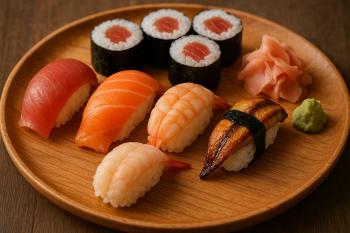
Sushi features vinegared rice seasoned with sugar and salt and topped or rolled with seafood, vegetables or egg. Styles range from hand‑formed nigiri to rolled maki and scattered chirashizushi. It is Japan’s best‑known dish worldwide and represents a perfect harmony of rice, fish and delicate seasoning.

Donburi is a rice bowl topped with savoury ingredients simmered in soy and mirin. Popular varieties include gyūdon (beef and onion), katsudon (pork cutlet), oyakodon (chicken and egg) and kaisendon (raw seafood). It’s a quick, filling meal found everywhere from casual diners to specialty shops.

Onigiri are portable rice balls wrapped in nori and filled with salmon, pickled plum or seasoned kelp. They are lightly salted and widely available at convenience stores and izakaya. Their simplicity makes them a classic snack for travellers.

Japanese curry rice is a comforting plate of rice smothered in thick, mildly spiced curry sauce. Introduced from Britain, curry has become a staple served at inexpensive eateries near train stations. Toppings like pork cutlet turn it into a hearty meal.
Noodle Dishes
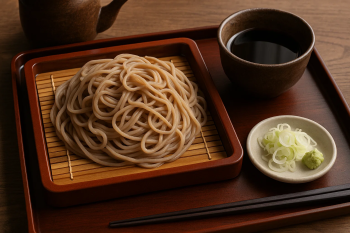
Made from buckwheat or a buckwheat‑wheat mix, soba noodles have a nutty flavour and can be enjoyed cold with dipping sauce or in hot broth. Soba restaurants often highlight regional buckwheat varieties.
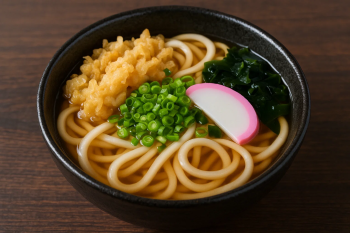
Udon are thick wheat noodles served hot or chilled with toppings like fried tofu (kitsune udon), tempura (tempura udon) or mountain vegetables (sansai udon). Their chewy texture makes them wonderfully satisfying.
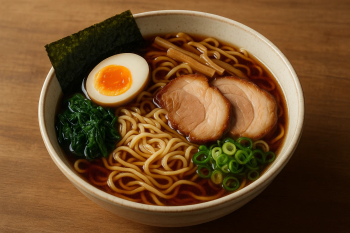
Ramen consists of Chinese‑style noodles in soup and has been embraced as a Japanese favourite. Broth styles include soy (shōyu), miso, salt (shio) and rich pork bone (tonkotsu). Each region boasts its own spin on this beloved dish.
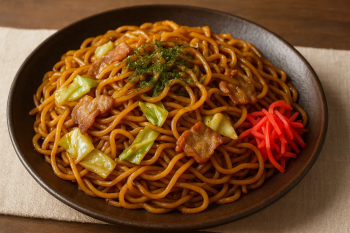
Yakisoba are stir‑fried noodles mixed with meat, cabbage and carrots and garnished with pickled ginger. They’re a festival staple and pair perfectly with a cold beer on a summer evening.
Hot‑Pot and One‑Pot Dishes
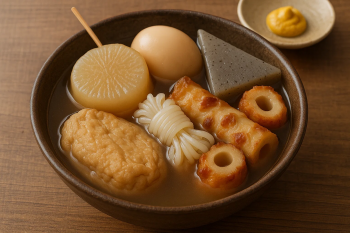
Oden is a winter comfort food featuring fish cakes, daikon radish, boiled eggs, konnyaku and seaweed simmered in soy‑based broth. Convenience stores often sell oden, making it easy to try.
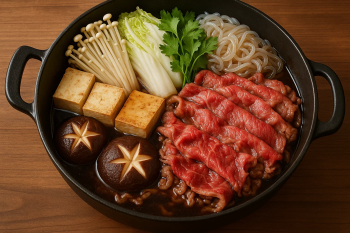
Sukiyaki combines thinly sliced beef, tofu, mushrooms and vegetables simmered in sweet soy broth. Diners dip each piece into raw egg before eating. It’s a popular meal for celebrations.
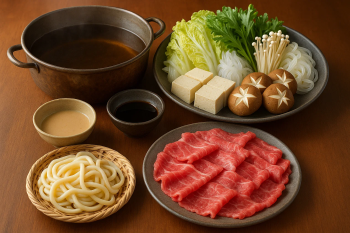
Shabu‑shabu is a communal hot pot where diners swish slices of beef or pork and vegetables through boiling broth and then dip them into citrusy ponzu or sesame sauce. The name mimics the “swish‑swish” sound of cooking.

Originating with sumo wrestlers, chanko nabe contains meatballs, seafood and vegetables simmered in a rich broth. Specialty restaurants around Tokyo’s Ryogoku district serve authentic versions.
Meat and Seafood Dishes

Yakitori are skewered chicken bits seasoned with salt or tare sauce and grilled over charcoal. Almost every part of the bird is used, from thigh and breast to liver and gizzard. Enjoy them at street stalls or dedicated yakitori bars.

Tonkatsu is a breaded, deep‑fried pork cutlet served with shredded cabbage and sweet sauce. When placed on rice and topped with eggs it becomes katsudon, and it’s also used to crown curry rice.
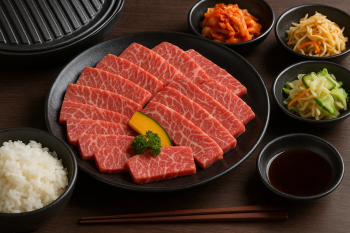
Yakiniku means “grilled meat.” Diners cook bite‑sized beef or pork on tabletop grills and dip pieces into a soy‑ and miso‑based sauce. Different cuts and marbling grades are offered, making it a favourite for meat lovers.

Nikujaga translates to “meat and potatoes.” This home‑style stew consists of sweetly simmered meat and potatoes. It’s simple, comforting and often evokes nostalgic feelings.
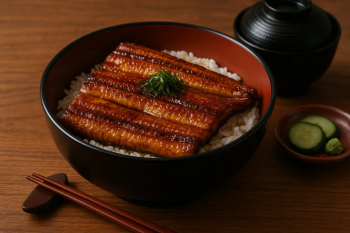
Freshwater eel, often grilled kabayaki‑style, is basted with a savoury‑sweet sauce and served over rice. Many Japanese believe eating unagi helps combat summer fatigue.
Soybean and Side Dishes

Miso soup is made by dissolving miso paste in dashi (fish stock). Common additions include wakame seaweed, tofu and fried bean curd. A bowl of miso soup is served with nearly every traditional meal.
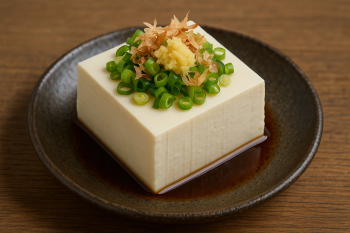
Hiyayakko is chilled tofu topped with grated ginger, bonito flakes and green onions. A splash of soy sauce completes this refreshing summer side dish.

A specialty of Kyoto, yudōfu consists of tofu gently simmered in a mild broth and dipped in soy or ponzu sauce. It’s especially popular in winter.
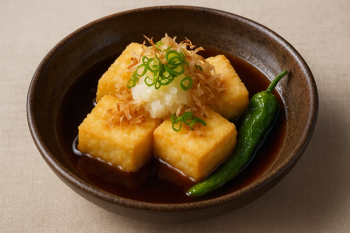
Lightly breaded tofu is fried until crisp and served in hot dashi soy sauce. Garnishes like green onion or grated daikon add extra flavour.
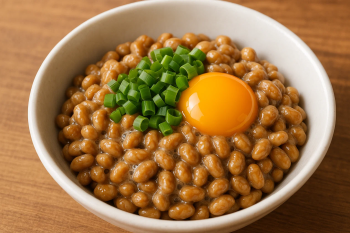
Natto are fermented soybeans with a sticky texture and strong aroma. Rich in protein and probiotics, they’re often eaten over rice or with soy sauce and mustard. The dish is polarising but loved for its health benefits.
Sweet Treats and Snacks
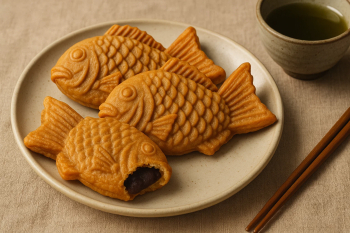
Taiyaki are fish‑shaped cakes filled with sweet azuki bean paste or custard. Their crisp exterior and gooey interior make them a beloved street snack.
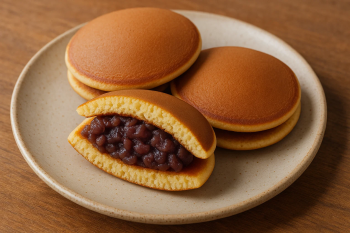
Dorayaki features two fluffy pancakes sandwiched around red bean paste. It’s a popular children’s treat and can also include custard, chocolate or chestnut filling.

Mochi is pounded glutinous rice formed into chewy cakes. Daifuku are mochi stuffed with fillings like sweet beans or strawberries, offering a mix of textures.

Dango are skewered rice dumplings grilled and coated with sweet soy glaze, anko red bean paste or sesame. They are commonly enjoyed during festivals.
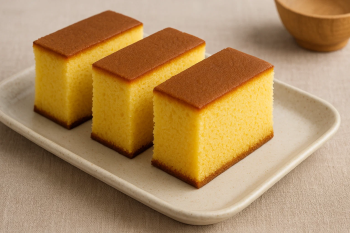
Castella is a sponge cake introduced by Portuguese merchants. Nagasaki’s version is moist and subtly sweet, now considered a regional specialty.
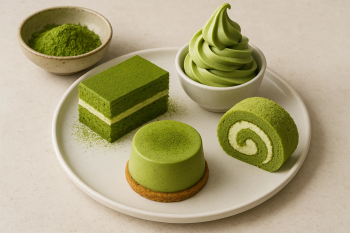
Japan’s love of green tea extends to sweets like matcha parfaits, matcha tiramisu and matcha ice cream. The earthy bitterness of matcha balances the sweetness of creams and cakes.
Practical Tips for Food Lovers
- Seek regional specialties
-
Every prefecture prides itself on unique dishes—try miso katsu in Nagoya, okonomiyaki in Osaka and goya champuru in Okinawa.
- Visit markets and depachika
-
Food halls in department store basements are treasure troves of snacks and prepared foods.
- Mind manners
-
Slurping noodles is acceptable and shows appreciation; tipping is uncommon; and passing food with chopsticks is avoided (use plates instead).
- Join a food tour
-
A guided tour provides background on local dishes, etiquette and hidden eateries.
Book here for food tours →
Conclusion
Reviews
There are no reviews